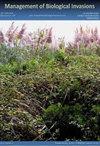Evaluation of five trap designs for removal of invasive red swamp crayfish (Procambarus clarkii Girard, 1852) in Southern Michigan: catch per unit effort, body size, and sex biases
IF 1.2
4区 环境科学与生态学
Q3 BIODIVERSITY CONSERVATION
引用次数: 2
Abstract
Trapping and removing invasive crayfish is one of the most common forms of control, however gear-specific biases can limit effectiveness of such methods. We evaluated five trapping gears (Gee’s minnow traps [GMT], pyramid traps [PYR], artificial refuge traps [ART], additional partition refuge traps [APART], and juvenile traps [JUV]) for their effectiveness in a Procambarus clarkii Girard, 1852 (red swamp crayfish) removal effort among four Southern Michigan ponds between May and October 2019. Our objectives were 1) determine which gear(s) produce the highest catch per unit effort (CPUE); 2) assess gears for body size and sex biases; 3) ascertain the degree of seasonality in gear-specific catches and biases. We found that baited GMT and PYR traps substantially outperformed the ART, APART, and JUV traps with respect to CPUE. However, catches of refuge-style traps trended positively over the season. Body size biases were prevalent, with GMT and PYR traps consistently recording individuals > 30 mm carapace length. The ART and APART traps caught relatively smaller individuals but trended towards capturing larger individuals later in the season. We observed no sex biases or biases between Form 1 and Form 2 males among the gears. Our findings support employing multiple gears for crayfish removals but demonstrated that baited traps can remove more crayfish than unbaited traps (on a CPUE basis) and both can capture body size trends by accounting for the timing of capture. Further, the lack of sex bias suggests any of these commonly used traps can be used to broadly sample females or male reproductive forms. Based on our results and recommendations, the Michigan adaptive response strategy has adopted a combination GMT-APART strategy to maximize CPUE while also targeting a wide range of crayfish sizes.对南密歇根州入侵红沼泽小龙虾(克氏原螯虾,1852年)的5种捕集器设计的评价:单位捕获量、体型和性别偏差
捕获和清除入侵的小龙虾是最常见的控制形式之一,然而,特定设备的偏见会限制这种方法的有效性。2019年5月至10月期间,我们评估了5种诱捕装置(Gee’s minnow陷阱[GMT]、金字塔陷阱[PYR]、人工避难陷阱[ART]、额外分区避难陷阱[APART]和幼鱼陷阱[JUV])在密歇根州南部4个池塘中对1852年克氏原螯虾(红色沼泽小龙虾)的清除效果。我们的目标是:1)确定哪个渔具单位努力渔获量最高(CPUE);2)评估身体尺寸和性别偏见的齿轮;3)确定特定渔具渔获量和偏差的季节性程度。我们发现,就CPUE而言,诱饵GMT和PYR陷阱的性能大大优于ART、APART和JUV陷阱。然而,在这个季节,避难所式陷阱的捕获量呈积极趋势。体型偏差普遍存在,GMT和PYR陷阱一致记录到个体的甲壳长度为30毫米。ART和APART陷阱捕获的个体相对较小,但在季节后期倾向于捕获较大的个体。我们没有观察到年级间的性别差异,也没有观察到年级一和年级二男性之间的性别差异。我们的研究结果支持采用多个时间段来清除小龙虾,但表明有饵陷阱比无饵陷阱可以清除更多的小龙虾(以CPUE为基础),并且两者都可以通过考虑捕获时间来捕获体型趋势。此外,缺乏性别偏见表明,任何这些常用的陷阱都可以广泛地用于女性或男性生殖形式的样本。基于我们的结果和建议,密歇根自适应响应策略采用了GMT-APART组合策略来最大化CPUE,同时也针对大范围的小龙虾尺寸。
本文章由计算机程序翻译,如有差异,请以英文原文为准。
求助全文
约1分钟内获得全文
求助全文
来源期刊

Management of Biological Invasions
Agricultural and Biological Sciences-Ecology, Evolution, Behavior and Systematics
CiteScore
3.40
自引率
6.70%
发文量
21
审稿时长
16 weeks
期刊介绍:
Management of Biological Invasions, established in 2010 by Dr. Elias Dana, is an open access, peer-reviewed international journal focusing on applied research in biological invasions in aquatic and terrestrial ecosystems from around the world. This journal is devoted to bridging the gap between scientific research and the use of science in decision-making, regulation and management in the area of invasive species introduction and biodiversity conservation.
Managing biological invasions is a crisis science, with Management of Biological Invasions aiming to provide insights to the issues, to document new forms of detection, measurements and analysis, and to document tangible solutions to this problem.
In addition to original research on applied issues, Management of Biological Invasions publishes technical reports on new management technologies of invasive species and also the proceedings of relevant international meetings. As a platform to encourage informed discussion on matters of national and international importance, we publish viewpoint papers that highlight emerging issues, showcase initiatives, and present opinions of leading researchers.
 求助内容:
求助内容: 应助结果提醒方式:
应助结果提醒方式:


